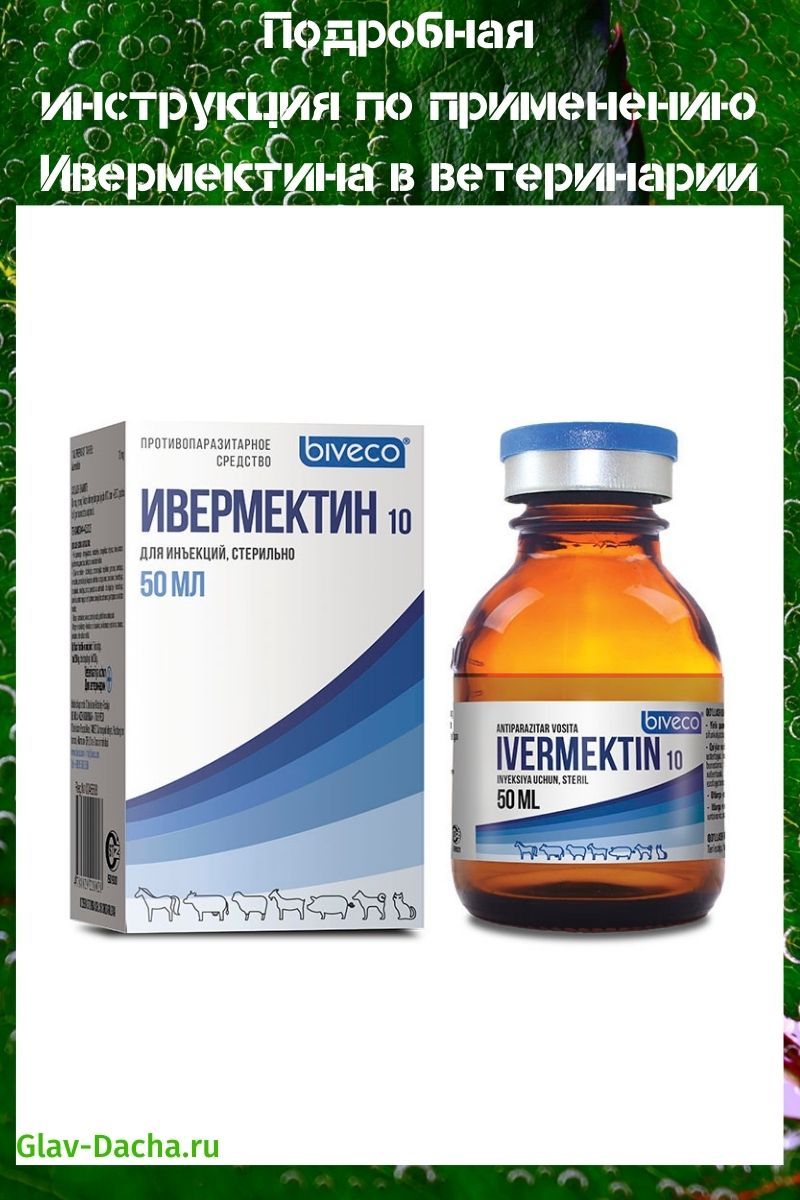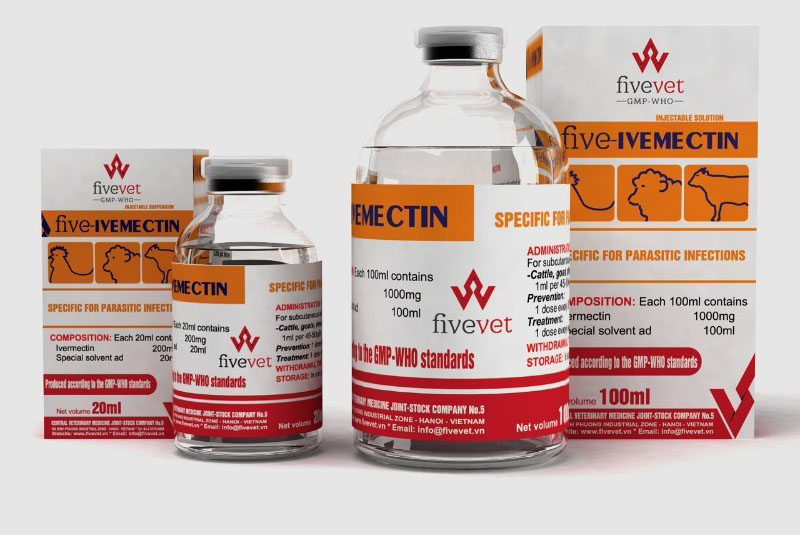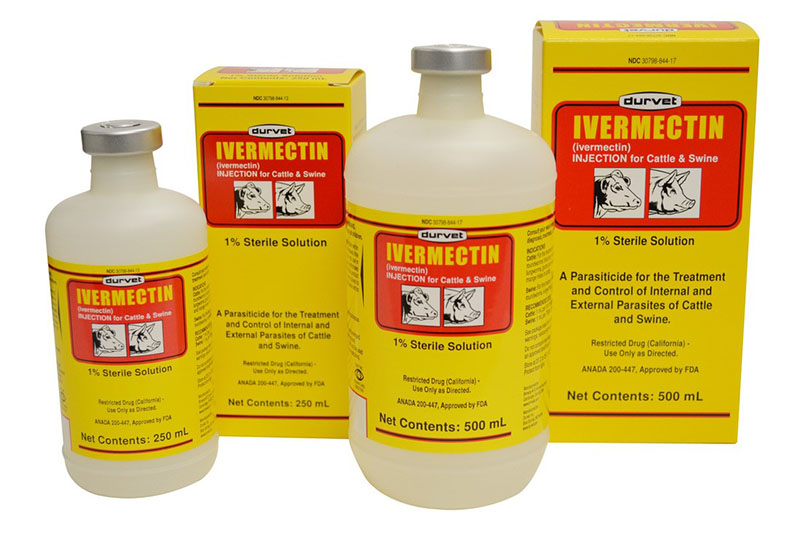Detailed instructions for the use of Ivermectin in veterinary medicine
 Ivermectin is a modern antiparasitic drug used to treat farm and domestic animals. Instructions for the use of Ivermectin in veterinary medicine recommends using it against nematodes in the lungs and organs of the gastrointestinal tract, gadflies, lice and ticks. The method of administration and dosage of the veterinary drug depend on the type and body weight of the animal.
Ivermectin is a modern antiparasitic drug used to treat farm and domestic animals. Instructions for the use of Ivermectin in veterinary medicine recommends using it against nematodes in the lungs and organs of the gastrointestinal tract, gadflies, lice and ticks. The method of administration and dosage of the veterinary drug depend on the type and body weight of the animal.
Composition and features of Ivermectin

Depending on the purpose of use, the drug is available in several forms.:
- Ivermec - this medicine contains ivermectin in combination with tocopherol. Available in the form of a clear or yellowish solution for injection.
- Ivermectin 10 is produced in the form of a clear, oily liquid for injection. The concentration of the active substance is 10 mg in 1 ml.
- Otodectin is a low-concentration injection solution containing 1 mg of ivermectin in 1 ml.
 Also in veterinary medicine, other forms of Ivermectin are presented - in the form of a spray, gel, paste and tablets for oral use. Otodectin is most commonly used in rabbits, guinea pigs and other small animals.
Also in veterinary medicine, other forms of Ivermectin are presented - in the form of a spray, gel, paste and tablets for oral use. Otodectin is most commonly used in rabbits, guinea pigs and other small animals.
For large ones, Ivermectin 10 is used, since it contains the maximum concentration of the active substance.
Main indications for use
 The instructions for the use of Ivermectin in veterinary medicine list the main indications for the use of the drug.
The instructions for the use of Ivermectin in veterinary medicine list the main indications for the use of the drug.
These include:
- cattle - stricturedosis, thelaziosis, habertiosis, trichocephalosis, mulleriosis;
- small ruminants - sifunculatosis, melophagosis, hypodermatosis, chorioptosis, psoroptosis, sarcoptic mange;
- pigs - strongyloidosis, ascariasis, trichocephalosis, sarcoptic mange, hematopinosis;
- horses - gastrofiliasis, rhinestrosis, onchocerciasis, strongyloidosis;
- chickens and other poultry - capillariasis, ascariasis, heterocytosis.
Ivermectin is considered a versatile drug for combating ectoparasites and helminthic invasions. The essence of its pharmacological effect is based on stimulating the production of GABA at the neuronal level. This causes a violation, and then a complete stop of vital impulses, leading to paralysis and rapid death of the parasite.
Ivermectin is fast acting, which starts within 1 hour after injection. The antiparasitic result lasts from 10 to 15 days.
Instructions for the use of Ivermectin in veterinary medicine
 For humans, the antiparasitic drug is most often prescribed as an oral tablet. The dosage of Ivermectin for a person is 10-12 mg, but it also depends on body weight. There should be an interval of at least 7-15 days between taking the medicine.
For humans, the antiparasitic drug is most often prescribed as an oral tablet. The dosage of Ivermectin for a person is 10-12 mg, but it also depends on body weight. There should be an interval of at least 7-15 days between taking the medicine.
In veterinary medicine, Ivermectin is most often used in the form of injection solutions. Before mass use of the drug, a trial test should be carried out on a group of animals of 5-8 animals.
For 3 days, you need to closely monitor the condition of the animals - in the absence of adverse reactions, you can inject the rest of the livestock.
For cattle and small ruminants
 In large and small ruminants, Ivermectin is most often injected intramuscularly, much less often - subcutaneously. The injection is done once, in the case of a severe form of sarcoptoidosis, two injections are allowed with an interval of 7-10 days. An injection of the medicine is made in the neck or croup.
In large and small ruminants, Ivermectin is most often injected intramuscularly, much less often - subcutaneously. The injection is done once, in the case of a severe form of sarcoptoidosis, two injections are allowed with an interval of 7-10 days. An injection of the medicine is made in the neck or croup.
For cattle and small ruminants, a dosage of 1 ml per 50 kg of body weight is used. If the animal weighs more than 400-500 kg, Ivermectin should be divided into several doses and injected into different parts of the body.
Livestock can be treated with Ivermectin to prevent nematodosis. In this case, the medicine is administered in the fall, before the animals move to the stall, and also in the spring, before they are released to the pasture. Treatment for ticks is carried out as needed.
For horses
 For the treatment of horses, a special form of Ivermectin is produced in the form of a paste. It has an apple aroma and taste, so animals do not refuse such a medicine. An antiparasitic drug is prescribed in a dosage of 2 ml for every 100 kg of body weight.
For the treatment of horses, a special form of Ivermectin is produced in the form of a paste. It has an apple aroma and taste, so animals do not refuse such a medicine. An antiparasitic drug is prescribed in a dosage of 2 ml for every 100 kg of body weight.
Ivermectin should not be used to treat young horses weighing less than 100 kg.
Veterinarians advise giving the drug to animals 3-4 times a year, preferably in spring and late summer, after the end of the summer of gadflies.
For pigs
 Ivermectin instructions for pigs are identical to those for cattle and small ruminants. But the injection is done in the neck or inner thigh.
Ivermectin instructions for pigs are identical to those for cattle and small ruminants. But the injection is done in the neck or inner thigh.
The recommended dosage of the drug is 1 ml for every 33 kg of pig body weight.
For poultry
For the treatment of chickens, ducks and other poultry, Ivermectin solution is added to the drink. The medicine is calculated at a dosage of 0.4 ml per 1 liter of liquid.
Birds should not receive more than 400 μg of active ingredient per kg of body weight.
It is advisable to stop drinking the bird 2-3 hours before taking Ivermectin. In case of nematodosis, the medicine is given to the livestock once, in the treatment of arachnoentomosis - three times (the second after 24 hours, the third after 14 days).
For rabbits
 Ivermectin 10 for rabbits used extremely rarely, since this form of the drug has a high concentration of the active substance. That is why it is very difficult to calculate the correct dosage of the drug.
Ivermectin 10 for rabbits used extremely rarely, since this form of the drug has a high concentration of the active substance. That is why it is very difficult to calculate the correct dosage of the drug.
The most commonly used is Otodectin, which has a lower concentration of the active ingredient. For treatment, Ivermectin for rabbits is used at a dosage of 0.2 ml per 1 kg of animal body weight.
For cats and dogs
 Ivermectin instructions for cats recommends using this medicine in the treatment of lesions by gadflies, nematodes, lice, fleas, ticks. The agent is effective against the larvae of subcutaneous and nasopharyngeal worms. The antiparasitic drug is prescribed in a dosage of 0.2 ml per 1 live weight of the cat.
Ivermectin instructions for cats recommends using this medicine in the treatment of lesions by gadflies, nematodes, lice, fleas, ticks. The agent is effective against the larvae of subcutaneous and nasopharyngeal worms. The antiparasitic drug is prescribed in a dosage of 0.2 ml per 1 live weight of the cat.
Ivermectin tablets for dogs are given at a standard dosage of 200 mcg per kg of body weight.
This norm is used only for adult dogs, puppies should not be given an antiparasitic drug. In no case should the indicated dosage be exceeded, as Ivermectin can cause side effects.
Overdose and side effects
 Subject to the dosage indicated in the instructions, Ivermectin is well tolerated by the animal's body. But it must be borne in mind that the drug can cause an allergic reaction.
Subject to the dosage indicated in the instructions, Ivermectin is well tolerated by the animal's body. But it must be borne in mind that the drug can cause an allergic reaction.
Ivermectin may cause side effects:
- increased salivation;
- upset stool;
- impaired coordination of movements;
- vomiting;
- disturbances in the work of the digestive system;
- lethargy and apathy.
In case of an overdose, the animal may show signs such as dilated pupils, tremors of the limbs, loss of consciousness and coma. In such cases, symptomatic treatment is prescribed to the animal.
Ivermectin is an effective antiparasitic drug used for farm and domestic animals. When used correctly and in accordance with the instructions, the product helps to get rid of gadflies, lice and fleas.